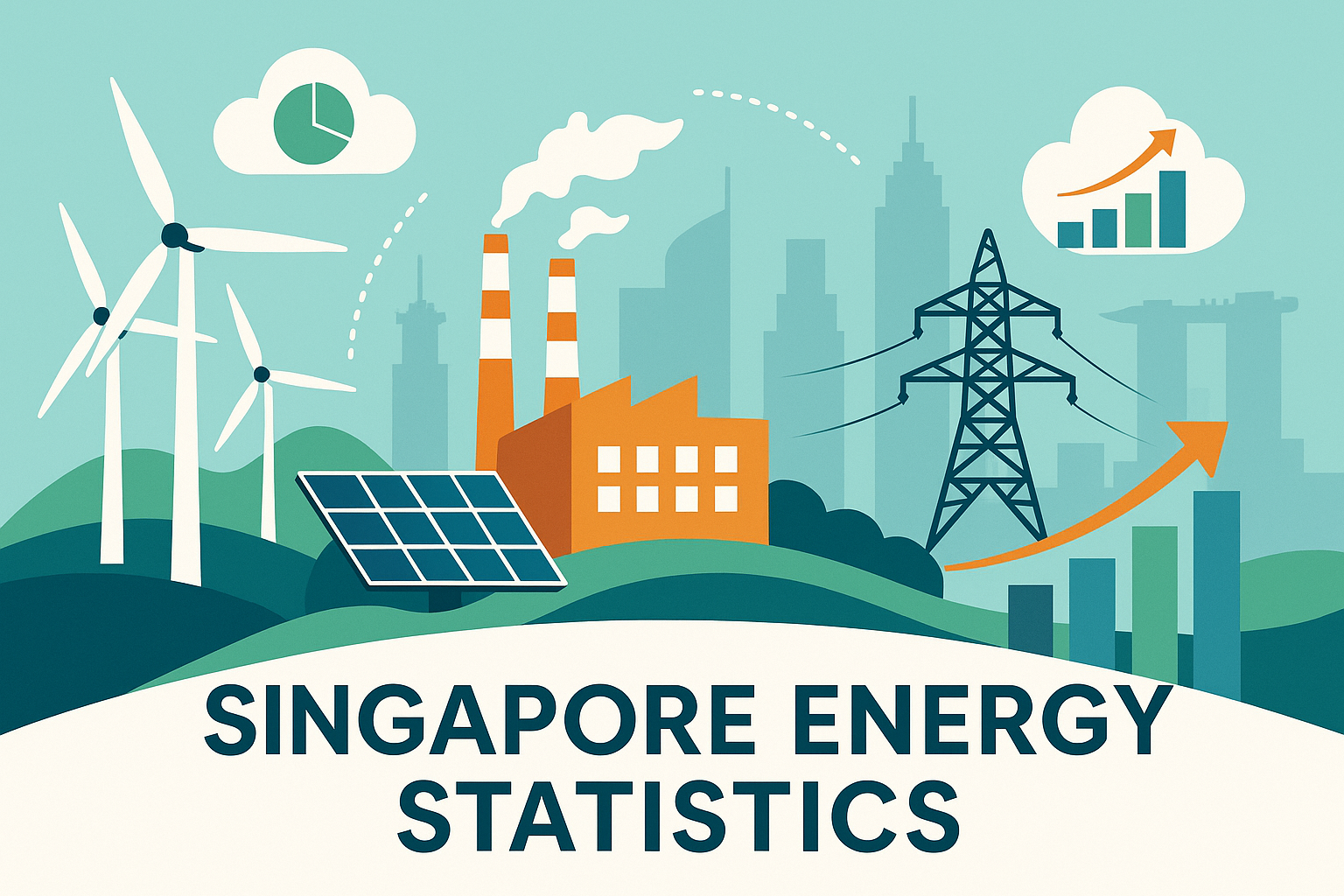Electricity Generation
In 2024, 10,533 ktoe (123 TWh) of energy inputs generated a gross electricity output of 5,126 ktoe (60 TWh). This was a 2.5% increase from 2023, reflecting continued growth in electricity demand.
As of 1H 2025, 5,163 ktoe (60 TWh) of energy inputs generated a gross electricity output of 2,546 ktoe (30 TWh).
Electricity Generation Input and Output
- 1H 2025
- 2024
- 2023
- 2022
- 2021
- 2020
- 2019







Note: Data for 2025 was as at Jun-2025.
Electricity Generation Industry
Generators Market Shares based on Electricity Generation
Tuas Power Generation, Senoko Energy and YTL PowerSeraya continued to hold significant market share in 2024. Their combined market share was 51.4% in 2024.
As of 1H 2025, Senoko Energy held 18.7% market share, Tuas Power Generation held 18.5%, and YTL PowerSeraya held 13.9%. The remaining market share was distributed among other generators including Keppel Merlimau Cogen, Sembcorp Cogen, and PacificLight Power.
Percentage Contribution to Total Electricity Generation (as at end period)
Note: Data for 2025 was as at Jun-2025.
Electricity Generation Capacity by Technology Type
Singapore's total electricity generation capacity decreased by 4.8%, from 13,072 MW in 2023 to 12,445 MW in 2024, following the decommissioning of older generation plants. However, capacity rebounded by 6.6% to 13,261 MW in the first half of 2025, as new generation units were commissioned, and solar capacity continue to expand.
In 2024, combined cycle gas turbine (CCGT), co-generation and tri-generation plants continued to account for the largest share (81.3% or 10,115 MW) of the total generation capacity. The remainder comprised of solar PVs (9.7% or 1,211 MWac), waste-to-energy (2.8% or 345 MW), electricity imports (2.4%, or 300 MW), open-cycle gas turbines (2.1%, or 260 MW), energy storage systems (1.6%, or 200 MW), and steam turbines (0.1%, or 14 MW).
In 1H 2025, overall generation capacity increased by 6.6%, driven mainly by the commissioning of new open-cycle gas turbines (rising from 260 MW to 1,042 MW) and continued growth in solar PV deployment, which expanded by 12.9% from 1,211 MWac in 2024 to 1,367 MWac in 1H 2025. These additions made up for the reductions from older plant retirements.
Singapore's overall capacity remains robust and adaptable, supported by plans to deploy new advanced CCGT units over the next few years. The steady rise in solar generation capacity is expected to continue, reinforcing Singapore’s commitment to renewable energy and sustainability goals. In addition, electricity imports have increased since 2023, further diversifying Singapore’s energy supply mix and enhancing system resilience.
Note: The abovementioned electricity generation capacity was based on the registration of generation facilities with Energy Market Company. For generation planning, the electricity generation capacity figures may be adjusted to account for fuel availability.
Electricity Generation Capacity by Technology Type (as at end period)
Note:
1. Data for 2025 was as at Jun-2025.
2. The abovementioned electricity generation capacity was based on the registration of generation facilities with Energy Market Company. For generation planning, the electricity generation capacity figures may be adjusted to account for fuel availability.
Fuel Mix for Electricity Generation
In 2024, Natural Gas accounted for 94.0% of Singapore’s fuel mix. Other Energy Products (e.g., Municipal Waste, Biomass, and Imports) accounted for 2.7%, Solar PV accounted for 2.1%, while Coal and Petroleum Products (1.2%) made up the balance.
In the first half of 2025, Natural Gas accounted for 93.1% of Singapore’s fuel mix, of which Other Energy Products accounted for 3.0%, and Solar PV accounted for 2.5%.
Electricity Generation Fuel Mix
Note: Data for 2025 was as at Jun-2025.
Grid Emission Factor
The Grid Emission Factor (GEF) measures the average CO2 emissions emitted per unit of net electricity generation in the system by all grid-connected power units. The GEF includes generation technologies from main power producers (e.g. combined cycle power plants, waste-to-energy) and autoproducers (e.g. embedded co-generation plants and solar).1
The Build Margin (BM) emission factor refers to the average CO2 emissions emitted per unit of net electricity generation by the most recently built power units. Singapore’s BM emission factor trends lower than the GEF as the most recently built power plants are generally more efficient as compared to the older plants.
Singapore’s average GEF decreased from 0.412 kg CO2/kWh in 2023 to 0.402 kg CO2/kWh in 2024. This was largely due to higher proportion of solar in our fuel mix and lower emissions intensities from power generation companies in 2024 as compared to 2023. The lower emissions intensities resulted from greater use of lower-carbon fuels such as municipal waste and biomass, and reduced use of more carbon-intensive fuels such as coal.
1 Autoproducers refers to enterprises that produce electricity but for whom the production is not their principal activity.
Grid Emission Factor
Energy Flows in the Oil Refining Sector
In 2023, a total of 42 Mtoe of refinery inputs (i.e. comprising 37 Mtoe of crude oil and natural gas liquids, and 6 Mtoe of other feedstocks) were utilised by oil refining sector, a 1.2% decrease from 43 Mtoe in 2022. These inputs were used for the production of refined products by oil refineries.1
These inputs yielded an output of 41 Mtoe of petroleum products in 2023, 2.1% lower than the output of 42 Mtoe in 2022.2 The output of petroleum products recorded for middle distillates (20 Mtoe) in 2023 was similar (0.4% higher) to that of 2022. On the other hand, light distillates (10 Mtoe) and heavy distillates (10 Mtoe) were about 2.4% and 6.3 % lower than their respective outputs in 2022.
1 An oil refinery takes crude oil and separates it into different fractions. The refinery then converts those fractions into usable products. These products are finally blended to produce finished petroleum products (e.g. gasoline, naphtha, jet fuels and fuel oils) as outputs.
2 Petroleum products can be classified under light distillates (e.g. LPG, gasoline, naphtha), middle distillates (e.g. kerosene, jet fuel, diesel), heavy distillates and residuum (e.g. heavy fuel oil, lubricating, wax).
Refinery Input and Output
- 2023
- 2022
- 2021
- 2020
- 2019





In This Chapter

Download
Data in this annual publication is accurate as of Sep 2025.
For enhanced visibility of the variables in the charts, you may filter them through the charts' legend.
















